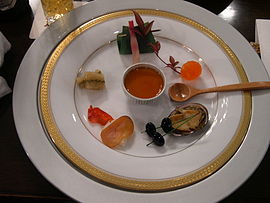- Rokusaburo Michiba
-
Rokusaburo Michiba Born 3 January 1931
Kaga, Ishikawa Prefecture, JapanCooking style Japanese cuisine Television show(s)In this Japanese name, the family name is "Michiba".Rokusaburo Michiba (道場 六三郎 Michiba Rokusaburō, born 3 January 1931) is a Japanese cuisine chef most notable as the first Japanese Iron Chef on the television series Iron Chef. He was on the show from its inception in 1993 until his retirement on his 65th birthday, January 3, 1996. After his retirement as an Iron Chef, he made sporadic appearances on the show, and producers even dedicated a special 1996 tribute episode to him called The Legend of Michiba. Rokusaburo Michiba originally balked at his blue attire (a samue outfit with a flat cap), but was flattered into wearing it.
According to his introduction, Rokusaburo Michiba was once considered a maverick for his philosophy of "there are no borders to ingredients." Although primarily a Japanese chef, Michiba was unafraid of incorporating decidedly non-Japanese elements into his dishes — something that did not sit well with more traditional-minded Japanese cuisine chefs. Indeed, in his first battle against French cuisine-trained Kobayakawa Yousei, Michiba was given a theme ingredient virtually foreign to Japanese cuisine: foie gras. Michiba was declared the winner. In fact, of his outstanding career win-loss record of thirty-two wins, five losses, and one tie, he, arguably, can take some personal and professional satisfaction that his record against the traditionalists is a fine ten wins and one loss.
Michiba's trademark was "Inochi no Dashi" (命の出汁; いのちのだし or "Broth of Vigor",) a combination of plenty of katsuobushi, skipjack tuna shavings and a form of edible kelp called "konbu," which he used during virtually every battle. He is also widely credited with introducing mayonnaise into Japanese cuisine.
Michiba was also skilled in calligraphy, often using precious minutes, usually at the beginning of a battle, to write a menu. On one occasion, however, Michiba forgot to write a menu and lost a battle; on another occasion, he did it at the last moment and lost as well. In an episode where his sous-chef challenged Iron Chef Masaharu Morimoto, Michiba explained that he wrote out his menu partly to clarify what he wanted to present, and partly to inform his assistants so that they would know which ingredients to gather and prepare. Several challengers also wrote out their menus during their battle; commentators referred to this as "taking a page out of Iron Chef Michiba's book."
His imaginative mind and skills allowed him to, on occasion, finish a battle earlier than expected and prepare extra dishes. Despite being the oldest of the Iron Chefs, he holds the Kitchen Stadium record for most dishes in a battle: eight. In each contest, he would also try to create one dish that an ordinary person could duplicate without specialized equipment or knowledge.
Because of his age, experience, and excellent time management skills, Rokusaburo Michiba was regarded as the senior Iron Chef. His "borderless Japanese cuisine" is often not only considered to be neo-Japanese in style, but a pre-cursor to neo-Japanese cuisine.
Michiba's tenure was interrupted by an illness in mid-1995 that briefly hospitalized him, and afterwards, although his cooking form was as good as ever, he began tiring from the stress of appearing on the show and running his three restaurants: Poisson Rokusaburo in Akasaka, and Ginza Rokusan-tei and Kaishoku-Michiba in Ginza. It only worsened during overtime battles which were made possible by the addition of a fourth judge.
According to Takeshi Kaga, after his decision to retire, Rokusaburo Michiba vowed to personally recruit his successor. The show continued with just Iron Chef French Hiroyuki Sakai and Iron Chef Chinese Chen Kenichi for two months. But, finally, it was announced that Michiba had completed his mission with the naming of Koumei Nakamura. "All my instincts told me he was the one," said Michiba. Initially, Nakamura refused, but was convinced to accept. Nakamura's first battle on March 1, 1996 was against French chef Kiyoshi Suzuki. During the introduction of the theme ingredient of the day, Chairman Kaga stated that he could not resist choosing foie gras, wanting to relive some of the magic of Michiba's first victory using the same ingredient.
Michiba was also extremely supportive of Nakamura's successor, Masaharu Morimoto. Inarguably, Morimoto took Michiba's "no borders to ingredients" philosophy to a different level. The show often referred to the relationship between Michiba and Morimoto as that between master and student, especially after an episode when Michiba flew to New York to visit Morimoto's restaurant, Nobu. So supportive of Morimoto was Michiba that, before his infamous New York battle with chef Bobby Flay, Michiba gave Morimoto a large box of katsuobushi flakes with a hand-calligraphed message: "respect the old, but seek out the new."
Michiba is 80 years old and he lives in japan.
Manga
The manga series Kandō Ō Retsuden featured a story about Michiba in volume 2, called Michiba Rokusaburō Monogatari. The data collecting and organizing was made by Yasuo Negishi and it was illustrated by Yoshihiro Takahashi.[1]
External links
References
- ^ Negishi, Yasuo; Yoshihiro Takahashi (15 July 1998). Kandō Ō Retsuden 2: Michiba Rokusaburō Monogatari. Japan: Shōnen Sunday Comics. pp. 101–190. ISBN 4-09-125412-8.
Preceded by
N/AIron Chef Japanese
October 17, 1993 - January 3, 1996Succeeded by
Koumei NakamuraCategories:- 1931 births
- Living people
- Japanese chefs
Wikimedia Foundation. 2010.

